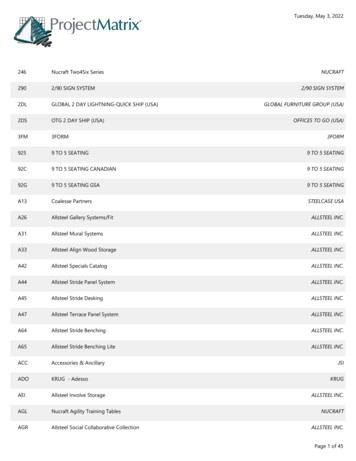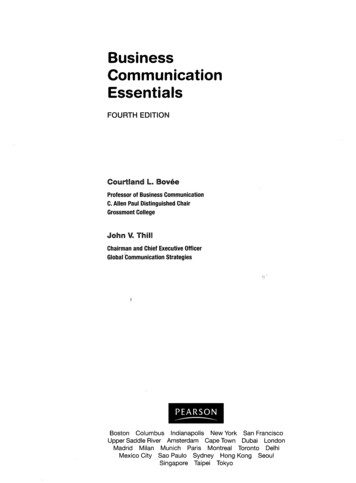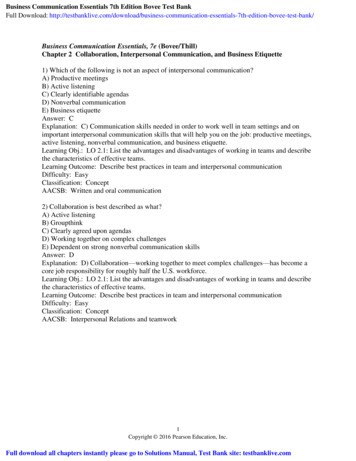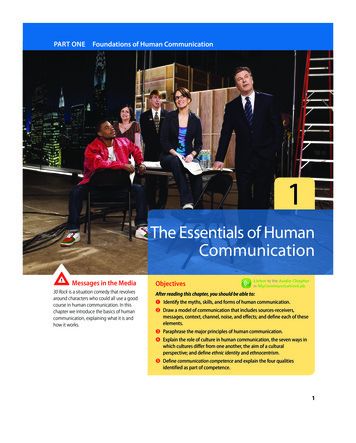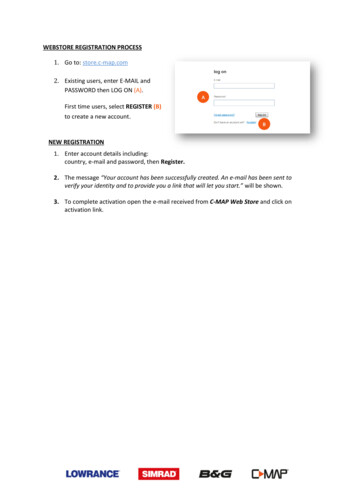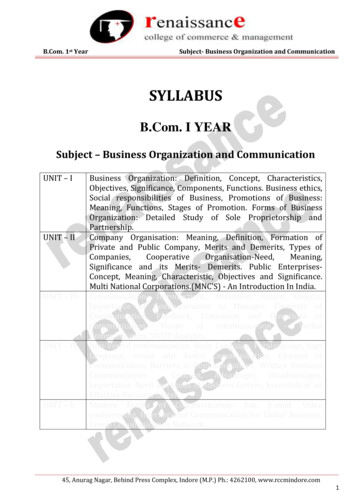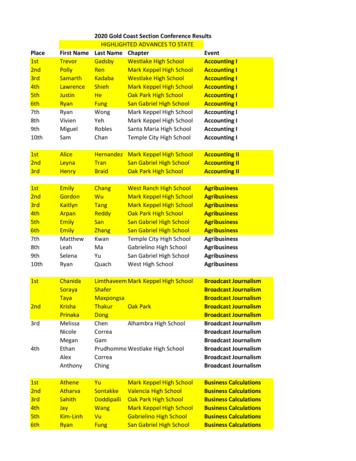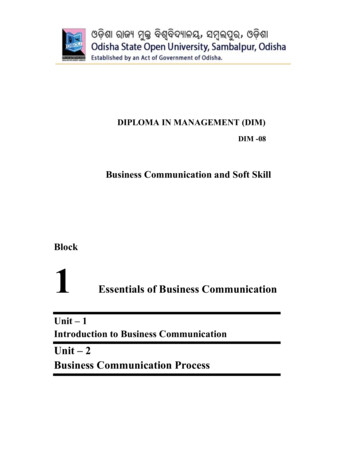
Transcription
DIPLOMA IN MANAGEMENT (DIM)DIM -08Business Communication and Soft Skill1BlockEssentials of Business CommunicationUnit – 1Introduction to Business CommunicationUnit – 2Business Communication Process
Diploma in ManagementEXPERT COMMITTEEProf. Dr. Biswajeet PattanayakDirector, Asian School of Business ManagementBhubaneswar, OdishaChairmanDr. Suresh Chandra DasDeptt. Of Commerce, UN College of Science andTechnology, Adaspur, CuttackMemberDr. Suddhendu MishraDept of Tourism and HospitalityManagement , BJB(Auto) College,BhubaneswarMemberDr. Ratidev SamalAssistant Professor,Regional CollegeBhubaneswar, OdishaMemberDr. Susanta K. MoharanaFormer Principal, Regional CollegeBhubaneswar, OdishaConvenerDIPLOMA IN MANAGEMENTCourse WriterDr. Sharmila SubramanianPrincipalAstha School of ManagementBhubaneswar (Odisha)Odisha State Open University2
Diploma in ManagementUnit – 1Introduction to Business CommunicationLearning ObjectivesAfter completion of the unit, you should be able to: Explain the meaning, concept and definition of business communication.Describe scope and importance of business communication.Know the various dimensions of business 1.10IntroductionDefinitionsScope and Importance of Business CommunicationDimensions of Business CommunicationBusiness Communication Skills for effective business managementLet’s Sum-upKey TermsSelf-Assessment QuestionsFurther ReadingsModel Questions1.1 IntroductionBusiness Communication is the nervous system of a business. Business cannothappen in the dearth of communication. According to well-known professorsWilliam Pride, Robert Hughes, and Jack Kapoor, business is 'the organized effort ofindividuals to produce and sell, for a profit, the goods and services that satisfysociety's needs.' A business, then, is an organization which seeks to make a profitthrough individuals working toward common goals. The goals of the business willvary based on the type of business and the business strategy being used. Regardlessof the preferred strategy, businesses must provide a service, product, or good thatmeets a need of society in some way. Now to run a business, businesscommunication becomes inevitable. Through communication, organizational goalsare disseminated to the individuals working in the organization; managementdecisions are informed to the workers; customers are made aware of the service,product, or goods sold by the organisation. Therefore business communication actsas an information-flow and controlling system for an organization.Odisha State Open University3
Diploma in ManagementThe success of a business depends on the efficacy of business communication,because in business communication, transactionoccurs between two or more partiesto exchange business related information. These parties can be the management, thegovernment, the workers, the managers, the customers, the shareholders and so on.Business communication takes place in various contexts-whethermaking abusiness presentation, conducting a meeting, mediating a dispute, writing up a mail,or negotiating a business deal. For example, a company like Amway usespresentation as the mode of information among a close-knit group of customers.Most of the FMCG (fast moving consumer goods) companies resort to TVadvertising to make consumers aware of their products. To communicate amanagerial decision, a manager may use an office order mail. An entrepreneur maysend in a proposal to the government to get approval for a start-up. All of these areformats of business communication.Business Communication is both a necessary and a challenging aspect of businesslife. A business may be the most innovative and efficient enterprise in its area but inorder to sustain and survive, it must be able to communicate the value of itsproducts and services to existing and potential customers. At the same time, thebusiness should also be able to integrate all its internal stakeholders through itsvision and mission so that the desired objectives may be achieved. It is appropriate toquote Mr. Kumar Mangalam Birla, Chairperson, Aditya Birla Group, “It is a realitythat is either ignored by a large number of managers or if accepted, it is given a lowpriority in the event of things. My interactions with thousand of professionals bothmen and women over a period of time has led me to believe that communicationplays a key role in the success of any human endeavor, whether it is personal orprofessional. Failure of any human effort is not so much a matter .of lack ofefficiency or competence than a matter of poor communication. This is more true inbusiness than in any other human activity ”Thus, effective business communication skills are the prerequisites to businesssuccess because individuals involved in business increasingly face aninformation overload and shorter time spans within which they are required toorganize their ideas and communicate them clearly and concisely. Businesscommunication skills can act as the magic wand that can help managers render theirservices with utmost sincerity and efficiency.The changes that have taken place in the business world reflect several developmentsin the way business communication skills are viewed. In fact, there has been a shiftin perspective, so that business communication skills take priority over coreprofessional skills. It is also true that professional knowledge is as important ascommunications skills but knowledge of highly sophisticated technical orprofessional courses will be useless if managers do not know how to communicateOdisha State Open University4
Diploma in Managementwith others about the information and insights which result from the use andapplication of these technical and professional skills.1.2 DefinitionsCommunication is the lifeblood of an organization. People in organizations typicallyspend over 75% of their office time in an interpersonal situation. As poorcommunication is at the root of a large number of organizational problems,organizations with effective communication dramatically outpace others. Thus,effective communication is an essential componentoforganizationaleffectiveness and thereby one of the top drivers of organizational success.Communication means sharing or exchange of thoughts or ideas. OxfordDictionarydefines communication as, “the transfer or conveying of meaning”.Communication is transfer of information from one person to another, whether or notit elicits confidence. But the information transferred must be understandable to thereceiver –G.G. BrownCommunication is the intercourse by words, letters or messages- Fred G. MeyerAccording to Brennan,Business communication is the expression, channeling,receiving and interchanging of ideas in commerce and industry.Communication is the art of being understood- Peter UstinovMost of the scholars use a working definition of communication that is“Communication is a process of sharing or exchange of ideas, information,knowledge, attitude or feeling among two or more persons through certain signs andsymbols or language- as you may call it”.Business Dictionary defines communication as a “two-way process of reachingmutual understanding, in which participants not only exchange (encode-decode)information but also create and share meaning.” It defines business communicationas, “The sharing of information between people within an enterprise that isperformed for the commercial benefit of the organization. In addition, businesscommunication can also refer to how a companyshares information to promote itsproduct or services to potential consumers.”Business communication can be defined as sharing of information between peoplewithin and outside the organization that is performed for the commercial benefit ofthe organization. It can also be defined as relaying of information withina business by its people.(Wikipedia)Odisha State Open University5
Diploma in Management1.3 Scope and Importance of Business CommunicationBusiness communication is a process where business related information, message,news, etc. are exchanged among buyers, sellers, producers, suppliers, competitors,government agencies etc. Business communication is essential to performmanagement functions and to ensure organizational success.1.3.1. Scope of business communication1.2.3.4.5.Scope of business communicationmeans the normal functioning area ofthis subject. Since communication is essential in every sphere of humanlife, its scope is wide and pervasive. From cradle to grave, human beingsare somehow engaged in communication. No one can pass even a daywithout communication. Similarly, an organisation cannot functionwithout business communication. The following is the scope of businesscommunication:Communication in business activities: In this post-modern age, we cannotthink of business without communication. Communication is the lifeblood ofbusiness as it provides necessary information in formulating business plansand policies. It also ensures effective performance of business activities likeproduction, distribution, finance, warehousing etc. Thus, ultimate success ofthe business depends on successful communication.Communication in management: Management is the means of achievingorganizational goals. Efficiency and effectiveness of management depend oneffective communication with the various internal and external parties. Everyfunction of management depends on communication. In fact, withoutinformation plans cannot be formulated, activities cannot be organized,directives cannot be issued and control cannot be ensured.Communication in industrial relations: Industrial relation means a labormanagement relationship in the industry or in an organization. Congenialindustrial relation is a precondition for business success. On the other hand,free and fair communication is a pre-requisite for creating good industrialrelation. Free flow of information lessens doubt, confusion and controversiesbetween workers and management. As a result, harmonious relationshipdevelops in the organization.Communication in Decision Making: Managers have to take decisions onvarious issues daily. Proper information is vital to make perfect decision andCommunication plays pivotal role here by supplying relevant information.Communication in international relations: This is the age of globalizationand due to tremendous development in communication; the entire world isviewed as a single village (global village). Changes are taking place all overthe world and in order to cope with the latest developments of the worldOdisha State Open University6
Diploma in Managementevery organization is expected to communicate with different quarters veryrapidly. The diplomatic, economic and trade relations between and amongnations in the international arena are based on effective andefficient Business Communication.6. Communication in Publicity: In this world of information, everyorganization is keen to advertise itself through some distinctive ways. ByCommunicating with concerned parties an organization does publicity also.7. Communication in cross-cultural environment:Business environment haswidened its perspectives. And now people of various cultures are working inan organisation giving scope for people to work and communicate in a crosscultural environment.8. Communication in media:Business is closely connected to the media.Media is used to inform people about the business, the product or the servicesoffered. This is done through newspaper, TV, radio, or social media. Thus,business communication has scope in this sector while dealing in advertising,media planning and marketing.1.3.2. Business CommunicationBusiness Communication is very important for any organisation. The followingpoints highlight the importance of communication:1.Exchanging information: Communication is mainly the exchange ofinformation between two or more parties. Through communication,organizations exchange information with internal and external parties.Communication also brings dynamism in organizational activities and helpsin attaining goals.2. Preparing plans and policies:Communication helps in preparingorganizational plans and policies. Realistic plans and policies requireadequate and relevant information. The managers collect required informationfrom reliable sources through communication.3. Execution of plans and policies: For timely implementation of plans andpolicies, managers must disseminate those in the whole organization. In orderto disseminate the plans and policies to the internal and externalparties,managers rely on communication.4. Increasing employee’s efficiency: Communication also helps in increasingthe efficiency of employees. With the help of communication, organizationalobjectives, plans, policies, rules, directives and other complex matters explainto the employees that broaden their knowledge and thus help them to beefficient.Odisha State Open University7
Diploma in Management5. Achieving goals: Effective communication helps the employees at all levelsto be conscious and attentive. It ensures timely accomplishment of jobs andeasy achievement of goals.6. Solving problems: Through various communication channels, the managerscan be informed of various routine and non-time problems of the organizationand accordingly they take the necessary actions of steps to solve theproblems.7. Making decisions: Making timely decisions requires updated information.Through effective communication, managers can collect information fromdifferent corners and can make the right decisions.8. Improving industrial relation: Industrial relation is the relation betweenworkers and management in the workplace. Good industrial relation is alwaysdesired for business success. Communication plays a vital role in creating andmaintaining good industrial relation.9. Publicity of goods and services: In the modern age, business is becominghighly competitive. Almost very competing manufacturer produces productsof common consumption. However, all of them cannot sell equally well. Theorganization that can communicate better, can also sell better.10. Removing controversies: Effective communication allows smooth flow ofinformation among various parties involved in the negotiation or transaction.As a result, conflicts, controversies and disagreements can be resolved easily.11. Enhancing employee satisfaction: If there is free and fair flow ofinformation in the organization, it will certainly bring mutual understandingbetween management and workers. Such understanding enhances thesatisfaction of employees.12. Enhancing loyalty: Effective communication helps the managers to be awareof the performance of their subordinates. In such a situation, the subordinatestry to show their good performance. Later on, if management praises theirperformance, it will enhance employees’ loyalty.Thus, business communication serves as the link between all the departments andfunctions of the organisation. Communication has many dimensions. Thesedimensions make communication in an organisation effective and efficient.1.4 Types / Dimensions of Business CommunicationThere are various dimensions of communication. It can be based on use of language1. Verbal and non-verbal; 2.Oral or written based on mode of expression;3.Formal and informal based on relationship; 4.Upward, downward, horizontalor diagonal based on organisational structure; and 5.Interpersonal, group or massbased on number of people involved in the process of communication.Odisha State Open University8
Diploma in ManagementDimension 1: Verbal and non-verbal based on use of language;Dimension 2: Oral or written or audio-visual based on the medium used;Dimension 3: Formal and informal based on the channel;Dimension 4: Upward, downward, horizontal or diagonal based on formalorganisational structure;Dimension 5: Interpersonal, group or mass based on number of people involved inthe process of communication.Verbal and Nonverbal CommunicationVerbal communication consists of words. It is not only oral but also written.Generally, people consider oral communication synonymous to verbalcommunication. Well, it is because one of the meanings of “verbal” is “oral” in thedictionary. Verbal communication can be broadly categorized into speech andwriting. Speech communication includes face-to-face conversation, talking over thephone, public address, presentations, meetings and so on. Written communicationinvolves writing letters, emails, memos, proposals, reports and the like.According to various surveys conducted across globe, about 80% of the time amanger in the organisation spends communicating with others. And most of thecommunication is oral in nature which is assisted by nonverbal communication. Asdiscussed earlier, verbal communication uses “words” or “language” fordisseminating information whereas, nonverbal communication does not. For examplethe expression “Parking Area” is verbal, but “” is nonverbal as it is a symbol.Nonverbal communication basically unveils an individual’s behaviour. It reflectsthe personality and temperament of a person. Therefore, managers are expected tounderstand the meaning of nonverbal cues- singular and clusters. Nonverbal cuesconsist of kinesics, proxemics, paralanguage, sign language, time language, objectlanguage, action, silence, and demonstration.Body language is into two categories namely, Kinesics and Postures. Somescholars from the U.S have tried to develop a vocabulary of body language calledkinesics. This is based on the supposition that body movements may also generate avocabulary of communication, unique to each culture. Thus, kinesics can be studiedthrough facial expression, gestures, eye contact, appearance, space, tactile andodour.Facial expressions convey a lot more information than words can ever say. A frownon the face shows discontent, a smile shows joy, engrossed look with palm on thechin shows thinking and red face with a stern look and clipped lips under teethconveys anger. These instances prove how important are facial expressions foreffective communication.Odisha State Open University9
Diploma in ManagementGestures are expressions communicated through body movements especially withthe help of hands, neck and shoulder. Curling of the fingers in and out at someonemeans “come here”, waving of hand means “good bye” etc Gestures have differentmeanings in different cultures. Smile and cry are the only universal gestures thathuman beings across globe use to express pleasure and despair respectively.Eye contact is quite helpful in learning about a person. Looking at someone in aface-to-face discussion usually refers to looking into the eyes of person. The eyesalong with the eyebrows, eyelids and pupils convey feelings of people. For example,raised eyebrows with dilated pupils show that the person is surprised, excited orfrightened.Appearance includes the body structure, shape and posture. People with heads heldhigh with a straight body posture are considered to have a good personality. Thesepeople are perceived as ones with great integrity, confidence and self-respect asagainst ones who bow their heads down or keep leaning. Body shapes also create animpression on the on-looker. Fat and soft people, often evoke laughter as they areperceived as lazy and inactive. Tall, thin and youthful people are accepted better inthe society than their fatter counterparts.The distance between persons conversing face-to-face can be divided into intimate,personal, social and public space. According to Edward.T.Hall, social scientist,intimate distance is from physical contact to 18” (between close friends andrelatives), personal distance is from 18” to 4’ (between comrades, peers etc ), socialdistance is from 4’ to 12’ (between officials of various cadres) and public distance is12’ and above (while communicating with a large audience). This type of spacedistancing between people is called proxemics.Touch is also a non-verbal form of communication. This referred to as haptics.While shaking hands with a stranger, one can realize whether the person is tough,warm, gentle or flirtatious. This can be made out through touch. A child reciprocateswell to its mother’s touch, whereas it retaliates when the touch sounds unfamiliar.Thus, touch is an integral part of communication that can help understand a personbetter.Many cultures in the world have often emphasized the importance of smell(olfactics) in knowing about an individual’s personality. This is included in the nonverbal communication as odour. With the western corporate culture growing, peopleare getting used to various kinds of deodorants to hide their body smell.In fewcultures fragrance is an important part of one’s personality like in middle-east Asiancountries. In India too, women are supposed to possess sweet smell to depict theirgentle nature.Posture is a part of body language. It has been discussed in brief in the section“appearance”. Posture is not just an aspect of appearance, but is an effective form ofnon-verbal communication. Standing erect with straightened shouldersOdisha State Open University10
Diploma in Managementcommunicates that the person is dynamic and active. At the same time, a person withleaning back and drooping shoulders appears to be lazy. Similarly sitting posturesalso effect communication. These examples can be visualized in a seminar situation.If the speaker is leaning or bending, audience loses interest very easily.But if thespeaker is maintaining a straight posture, the audience appears active.ParalanguagePara means “like”. Paralanguage refers to the manner in which language is spoken.To understand this better, let us consider this sentence- “She is clever”. This sentencecan be spoken in different ways-a) She is \clever. (Fall in the tone indicates a statement.)b) She is clever. (Rise in the tone indicates a question.)c) She is ˇclever. (Fall- rise tone indicates that the speaker is implyingsomething that is not spoken.)Thus, paralanguage is the “how” in spoken language, while the words and sentencesare a part of “what” in oral communication. Paralanguage includes voice, volume,speed, stress, intonation, pitch and pause. This is quite apparent when we listen toa speech. The voice quality attracts us to the speaker. For example, voice of thefamous film star Amitabh Bachchan attracts audience due to its clarity, modulationand depth. Volume and speed are also important in oral communication. Loudness ofvoice, usually, depends on the audience a speaker addresses. Any unusual use ofloudnesscan lead to poor communication.Object LanguageThe objects that people possess have a language of their own. This includes the dressthat is worn, the accessories and other possessions that are carried or exhibited. Forexample, one can make out that a person is a lawyer or a doctor by his or herovercoat. People wearing watch are considered to be time conscious and those withgorgeous ornaments are perceived to be rich. Similarly clean dress with polishedshoes is a symbol of smartness. Thus, objects and dresses communicate about aperson and cannot be neglected as petty things.Time Language“Time and tide wait for none”- this an age old saying and so people who respect timecommunicate sincerity, discipline and alertness. Time is also equated with money. Alatecomer is not perceived to be sincere and people avoid giving such a personresponsible tasks. Similarly procrastination is considered to be a symbol ofirresponsibility. Thus, time communicates about a person’s nature. It is also true thatthe importance that we attribute to time is culture specific. In western culture, there isnothing more important than time. But in Indian culture, we have a relaxed attitudeto time.Odisha State Open University11
Diploma in ManagementSign LanguageSigns and symbols are the most primitive forms of communication. The cavepaintings by early man are examples that our ancestors used signs and symbols toexpress themselves in times, as early as, the Stone Age. The sign language is a partof modern day communication also. The visual or graphical signs like no parking, nosmoking, traffic lights etc are good examples of modern day sign language.Sign language can be visual and audio. All the pictorial, graphical and physicalrepresentations come under sign language. Even the gestures meant to communicatewith people who are hearing impaired come under sign language.The jingle associated with a particular object, organisation or person is an example ofaudio sign language. Fire alarm, police siren or siren of the ambulance communicateemergency. Thus, signs and symbols are an important part of nonverbalcommunication.Action, Silence and DemonstrationAction language is a combination of body language and other forms of non-verbalcommunication. When we see a man, from a distance, with a spade in his handandgoing up and down with the spade, we can make out that he is digging. We guessthat because of his action. Various forms of dances and dramas are examples ofaction language. In a corporate situation, effectiveness of communication is judgedby the following course of action. Thus, action is vital form of communication.Silence is also a form of communication. Though silence is interpreted in differentways in different circumstances, nevertheless it is very important for properunderstanding. Silence while working means concentration and discipline. Silence ina funeral is respect. Silence in a work place without any work means protest. Silenceof an accused in the court room is acceptance of guilt, and silence of the topmanagement on the bonus issue means non-acceptance. Thus, silence communicates.Pictorial demonstration in the manual that is given with electronic equipment helpsin learning the operation of the equipment. Most of the time, pictorial instructions areunderstood better than the written instructions. This is a form of non-verbalcommunication that is demonstration. Demonstration can be of two types viz pictorial or graphical and physical. Physical demonstration is done under simulatedsituation. Demonstrating an operation in the operation theatre or a director enacting acharacter for the benefit of the actor, are examples of live or physical demonstration.Salespersons display and demonstrate their products in kiosks along pedestrian paths,office exits and petrol pumps. This is done to give customers a first hand experienceof the product and lure them into buying the product. Test drives are excellentexamples of live demonstration.Formal and Informal CommunicationOdisha State Open University12
Diploma in ManagementExpressions can also be formal or informal based on the way they are uttered. Thesedifferences come into being due to proximity, nature of interaction (scheduled orunscheduled) and mode of transmission of the messages. Formal communication, asthe word suggests, is more organised and has official sanction. On the contrary,informal communication, also called the grapevine, is unplanned and emerges frominformal relationship people share. So while meetings, planned discussions,extending courtesy and the like are formal forms of communication, gossip, idle talk,personal chats and unscheduled exchanges are informal forms.The degree of formality in the choice of words used in a piece of conversation alsogets affected by situation and relationship. “All participants are requested to goupstairs” is a formal expression whilst “up you go chaps” is informal.Communication is not always formal. In fact informal communication is far moreactive in the workplaces than formal communication. According to a studyconducted by Whittaker, people at workplace spend between 25% to 70% in face-toface conversations, and about 88% to 93% in unscheduled communication. Thisshows the widespread prevalence of informal communication in corporate houses.As per a research study conducted by J. David Johnson the difference betweenformal and informal communication can be cited as, “informal communicationusually does not follow the organisational chart and tends to be more personal, forexample, work-related discussions with co-workers, calling friends in another workunit on how to handle a work problem, etc. Formal communication is considered tobe “official” such as oral communication up and down the organisational chart andwritten communication contained in formal memoranda and departmentaldirectives.”Interpersonal, Group and Mass CommunicationCommunication can be interpersonal or mass depending on the number participantsinvolved. It also depends on the factors like sense of immediacy, intimacy, involvedtone, shared knowledge and experience. Interpersonal communication essentially hasclearly defined communicators whereas mass communication includes one and allwithout much ado about specific identification. Therefore, a face-to-face interactionis interpersonal and a news telecast or broadcast is mass communication. A letter fora specific audience is interpersonal and a newspaper article is mass communication.In an organisational situation, memos, office orders, letters and circulars can betagged as interpersonal communiqué. Advertisements, publicity and promotionalmaterials are for mass information and thus they are referred to as masscommunication.Group communication refers to involvement of more than two persons in the processof communication. It relates to transactions among the members of the group whoare required to be involved in the process and the communication is incompleteOdisha State Open University13
Diploma in Managementwithout their participation. Meetings, group discussions, panel discussions andconferences etc are examples of group communication. Informal group interactionin organisations is also group communication. A cohesive group makes a team onlyif the communication among the members is open and transparent.Upward, Downward, Diagonal and Horizontal CommunicationOrganisational Communication could be internal operationa
'lsorpd lq 0dqdjhphqw 2glvkd 6wdwh 2shq 8qlyhuvlw\ ï 8qlw ,qwurgxfwlrq wr %xvlqhvv &rppxqlfdwlrq /hduqlqj 2emhfwlyhv
